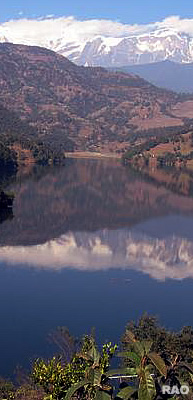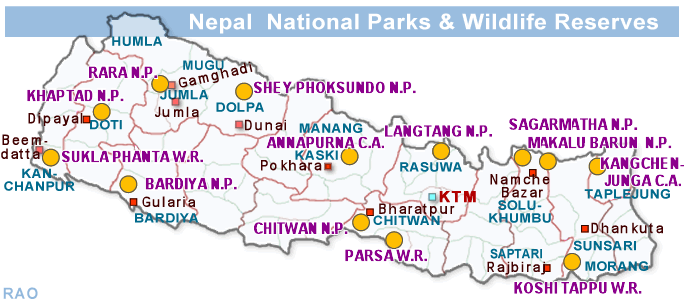 |
Sightseeings
in Nepal |
 |
| National
Parks & Wildlife Reserves of Nepal |
Uniqueness
of Nepal becomes transparent through the prism of its diverse biogeography,
ranging from the warm sub-tropical forests of Royal Chitwan National
park to the breathtaking beauty of Sagarmatha (Mt. Everest) National
Park which includes the highest peak of the world and a vast unfurling
range of summits of the Northern Himalayan region.
The
existing as many as six National parks, including four Wildlife
Reserves and a Hunting reserve in total occupy more than 7.30 percent
lead area of the most contrasting and spectacular natural lanscape
in the world.
 |
They exhibit every different type of altitudinal geographical
features and changing vegetation from the barren steppe of the trans-Himalayan
region in the extreme north; the hemlock, deodar and firn trees of
the higher altitude valleys and hills; pine and rhododendron of
the intermediate altitude to the great sal (shorea robusta) forests of the Terai and dun valleys in the southern region.
Almost
one hundred different species of mammals and more than 800 species
of birds survive in their natural habitat in these National parks of
Nepal.
The
Chitwan National Park has so far successfully managed to preserve and save
some of the most rare animals in threatening peril by protecting them in
its sprawling jungles.
The chief
aims of the National parks and Reserves are, primarily, to ensure
the conservation and management of the natural resources and
environment, including the flora and fauna as well as their habitats,
and secondly, to develop and promote nature and wild life tourism,
where suitable in such areas possessing tourist attractions, so
long as these activities are not detrimental to the implementation of conservation
programmes. |
|
Nepal
has so far succeeded in drawing appreciably increasing numbers of foreign
and regional tourists every year and it is evident that there is tremendous
potential of the national parks and the reserves for future expansion of nature,
wild life and jungle adventure holiday tourism.
National
parks now a days are gaining increasing importance as one of the most sought
after tourist attractions in the world and in recent years have
made major contribution in the spectacular growth of tourism in Nepal. Numerous
accommodation facilities hotels, wild life camps and cafeterias have
mushroomed in the park areas to cater to the increasing volume of visitors.
The
existing eleven parks and Reserves are widely spread throughout the country
and are located in all five development regions from east to west.
All
of these National Parks and Reserves are accessible by air followed
by road and few days walk (for mountain parks and reserves).
 |
 |
External
links |
|






